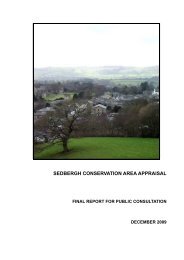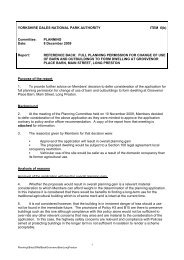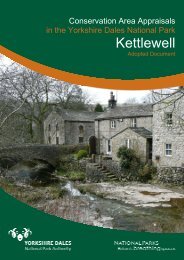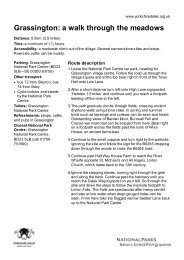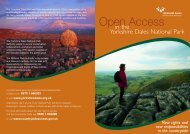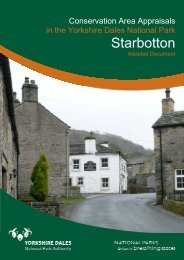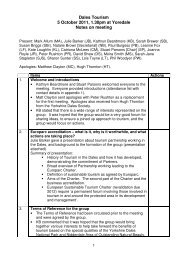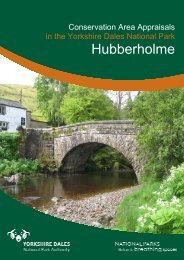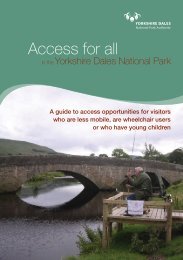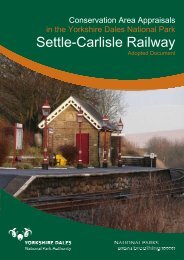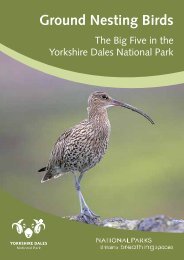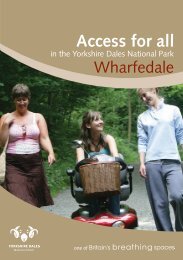Langcliffe - Yorkshire Dales National Park
Langcliffe - Yorkshire Dales National Park
Langcliffe - Yorkshire Dales National Park
- No tags were found...
Create successful ePaper yourself
Turn your PDF publications into a flip-book with our unique Google optimized e-Paper software.
Conservation Area Appraisalsin the <strong>Yorkshire</strong> <strong>Dales</strong> <strong>National</strong> <strong>Park</strong><strong>Langcliffe</strong>Adopted DocumentF
Table of ContentsPART I1.0 Introduction 41.1 The Area 41.2 The Appraisal 42.0 Planning Policy Framework 62.1 What Is a Conservation Area? 62.2 Benefits of Designation 73.0 Definition of Special Interest 93.1 General 93.2 Summary of the Special Interest of the <strong>Langcliffe</strong> ConservationArea 94.0 Assessing Special Interest 104.1 Location and Setting 104.2 Historic Development and Archaeology 144.3 Spatial Analysis 174.4 Character Analysis 235.0 Community Involvement 416.0 Suggested Boundary Changes 427.0 Local Generic Guidance 448.0 Summary of Issues 459.0 Useful Information, Appendices and Contact Details 469.1 References and Further Reading 469.2 Glossary of Terms and Abbreviations 479.3 Contacts 489.4 Maps of <strong>Langcliffe</strong> 49PART II10.0 Management Proposals 522
List of FiguresFigure 01: <strong>Langcliffe</strong> village 4Figure 02: Location maps 10Figure 03: Built-environment map regression 11Figure 04: Topographical features 12Figure 05: View onto <strong>Langcliffe</strong> village 12Figure 06: View alongside the B6479 13Figure 07: View onto <strong>Langcliffe</strong> Scar 13Figure 08: Places of employment 15Figure 09: Historical development of plan form 16Figure 10: Archaeological features 17Figure 11: Spatial character of built environment 18Figure 12: Definition of space 19Figure 13: Public and private space 19Figure 14: Key views from inside the village 20Figure 15: View 1 towards <strong>Langcliffe</strong> Place 20Figure 16: View 2 up the road to Malham 21Figure 17: View 3 over the Green towards the hills 21Figure 18: View 4 onto the Green 22Figure 19: View 5 onto the Green 22Figure 20: View 6 onto fountain 23Figure 21: View 7 onto central square 23Figure 22: Character zones 24Figure 23: Zone 1 – Built-up core 24Figure 24: Zone 3 – <strong>Langcliffe</strong> Hall estate 25Figure 25: Zone 4 – Bowerley 25Figure 26: St John the Evangelist 27Figure 27: Cock House and Grisedale 28Figure 28: <strong>Langcliffe</strong> Hall 29Figure 29: Manor Farm house and cottage 30Figure 30: Mount Pleasant Farmhouse 30Figure 31: Mount Pleasant House 31Figure 32: The Old Vicarage 31Figure 33: <strong>Langcliffe</strong> Institute 32Figure 34: Methodist Chapel and Wesleyan House 33Figure 35: Naked Woman date stone 33Figure 36: Sundial and relief 34Figure 37: Barn conversion to the west of Manor Farm 37Figure 38: Bungalow along the B6479 37Figure 39: Neutral architectural design contribution 38Figure 40: Barn near the Old Vicarage 38Figure 41: White-washed building 393
PART I1DCLG et al. (2010) PPS5:Historic EnvironmentPlanning Practice Guide,paragraphs 5, 6 & 8.1.0 IntroductionThe historic environment provides a tangible link with ourpast and contributes to our sense of national, local andcommunity identity. It also provides the character anddistinctiveness that is so important to a positive sense ofplace. […] The historic environment is a unique, fragile andnon-renewable resource which contributes to the economy,society and daily life. Once lost, it cannot be replaced 1 .This document provides the first comprehensive appraisal of the<strong>Langcliffe</strong> Conservation Area within the <strong>Yorkshire</strong> <strong>Dales</strong> <strong>National</strong> <strong>Park</strong>,although a brief report on the conservation area was written by MichaelLamb as part of An Appraisal of Settlements in the <strong>Yorkshire</strong> <strong>Dales</strong><strong>National</strong> <strong>Park</strong> in 1991.Throughout the text, the <strong>Yorkshire</strong> <strong>Dales</strong> <strong>National</strong> <strong>Park</strong> Authority will bereferred to as ‘we’, or ‘the Authority’.1.1 The Area<strong>Langcliffe</strong> was given conservation area status on 01 January 1978. It isnow one of thirty-seven such designations within the <strong>Yorkshire</strong> <strong>Dales</strong><strong>National</strong> <strong>Park</strong>. An area of 7.92 hectares encompasses most of the villageand some of its surroundings. The overall character of the place is bothinformal in terms of its historical development and rural due to itsvernacular architecture and natural landscape setting (figure 01).<strong>Langcliffe</strong> is a very attractive conservation area and generally in goodcondition (see 4.4.j).Figure 01: <strong>Langcliffe</strong> village:informal and rural character(photo © Gaby Rose, YDNPA,2009)1.2 The AppraisalPurpose. Every conservation area has a distinctive character which hasbeen shaped over time by its natural and man-made surroundings. Thisappraisal is an opportunity to re-assess the <strong>Langcliffe</strong> Conservation Area,to evaluate and record its special interest (see 3.0-4.0). It will set out howthe place has evolved, draw out the key elements of its character andquality as it is now, and define what is positive and negative, andopportunities for beneficial change. However, neither the designation norappraisal should be seen as an end in itself, but as a step towards thepreservation and enhancement of <strong>Langcliffe</strong>’s character and appearance,providing a basis for making sustainable decisions about its future.Conservation areas can be susceptible to incremental and dramatic4
change due to neglect caused by economic decline, as well as overinvestmentand pressure for development. Hence the appraisal aims tocounteract threats which would alter what made the area attractive andunique in the first place, and to help promote positive change.The appraisal provides information about the <strong>Langcliffe</strong> ConservationArea for residents, the wider public and other stakeholders. However, it isalways advisable to contact the Authority when planning to undertake anywork on listed buildings or structures within the vicinity of designatedheritage assets.Scope. This document is divided into two parts: The core of Part Iassesses the special interest of the <strong>Langcliffe</strong> Conservation Area, whilePart II contains draft management proposals.The appraisal was mainly created through use of primary sources likehistorical maps and aerial photographs from the Historic EnvironmentRecord as well as secondary sources, most of which are compiled on the<strong>Langcliffe</strong> homepage. Literature and websites which may be of furtherinterest are listed at the back (see 9.1). In addition, site visits to analysethe current physical evidence and condition of the conservation areawere undertaken during October and November 2009.A special thanks goes to Dr Michael Slater, resident of the village andchairman of its local history group, who has provided invaluable help forthe understanding of <strong>Langcliffe</strong>’s development.A draft version of this document was available for public consultation from27 January to 07 April 2010 (see 5.0). The comments received duringthat period were reviewed by the Authority before proposed changeswere put forward to the Members for approval at the Authority’s meetingon 25 May 2010. The <strong>Langcliffe</strong> Conservation Area Appraisal was finallyadopted on 29 November 2010.5
1234567Planning (Listed Buildingsand Conservation Areas) Act1990, section 69(1)(b).English Heritage (2006)Guidance on themanagement of conservationareas, paragraph 3.14.ibid, paragraphs 3.15 & 3.16.Planning (Listed Buildingsand Conservation Areas) Act1990, section 69(2).English Heritage (2006)Guidance on conservationarea appraisals & Guidanceon the management ofconservation areas.Planning (Listed Buildingsand Conservation Areas) Act1990, section 71.ibid, section 72.2.0 Planning Policy FrameworkThe YDNP Authority’s policies for conservation areas, along with otherrelated policies concerning development and the use of land, are set outin the <strong>Yorkshire</strong> <strong>Dales</strong> Local Plan 2006; the policies contained withinchapter 10 – built heritage and the historic environment – are particularlyrelevant. This plan is in compliance with the <strong>Yorkshire</strong> and Humber Plan,the area’s regional spatial strategy until 2026, as well as nationallegislation, policy and guidance which include Planning Policy Statement5: Planning for the Historic Environment and PPS5 Planning for theHistoric Environment: Historic Environment Planning Practice Guide.Further policies may be found in Planning Policy Statement 7:Sustainable Development in Rural Areas. All national legislation, policyand guidance are material to individual planning and heritage consentdecisions.Policies specific to listed buildings or conservation areas in the CravenDistrict Local Plan (1999) were not saved as because they eitherrepeated or were superseded by national planning policies.2.1 What Is a Conservation Area?Section 69(1)(a) of the Planning (Listed Buildings and ConservationAreas) Act 1990 defines a conservation area as:an area of special architectural or historic interest thecharacter or appearance of which it is desirable to preserveor enhanceDesignation. It is the duty of the local planning authority to designatesuch areas 1 , preferably with input from the local community. Yet thisshould never be undertaken solely in response to local pressure, toprovide an additional control to actual or perceived threats to thecharacter of an area or to secure the future of a particular building, butonly if an area is of sufficient special interest 2 . The quality and interest ofthe overall built historic environment rather than of individual buildingsshould be the prime consideration. Whilst the immediate setting of thearea also needs to be considered carefully and within reason, included inthe boundary[, … c]onservation area designation is not generally anappropriate means of protecting the wider landscape 3 .Review. It is also the duty of the local planning authority to regularlyreview its conservation areas and, where appropriate, designate newparts 4 . Likewise, if the original interest is so eroded by subsequentchanges that it is no longer special, boundary revisions or cancellationshould be considered.<strong>Langcliffe</strong>, like most of the conservation areas within the <strong>Yorkshire</strong> <strong>Dales</strong><strong>National</strong> <strong>Park</strong>, was designated prior to 1990 when there was no statutoryrequirement for an in-depth character appraisal. Therefore the existingdesignation may not be considered as sound by current standards. Theopportunity has consequently been taken to review the area inaccordance with current guidance from English Heritage 5 . This has theadditional advantage of producing a more robust and consistentdocument that can be of greater influence in the planning process.Performance. Further duties of the local planning authority comprise, inconsultation with the public, formulating and publishing proposals for thepreservation and enhancement of the conservation areas 6 . It will alsoseriously consider the desirability of preserving or enhancing theircharacter or appearance when exercising planning powers 7 . <strong>National</strong><strong>Park</strong> family indicators provide a tool to monitor the <strong>National</strong> <strong>Park</strong>Authority’s performance regarding these functions.6
Implications. Conservation area designation may result in resourceimplications for owners, developers and residents because of theincreased statutory controls and particular requirements for the repair andalteration of existing, or the construction of new, buildings. However,designation also brings considerable benefits which are outlined below.2.2 Benefits of DesignationConservation area status offers advantages to both the public and thelocal planning authority.The public. Conservation areas can enhance economic well-being andquality of life, as well as offer a certain amount of continuity and stabilityin a rapidly changing world. At the same time, conservation-led changecan make a positive contribution enabling communities to regenerate.When considering investment, appraisals should guide the form andcontent of development, enhancement of the public realm, trafficmanagement and outdoor advertisement. This value of an area isbeneficial to both owners and developers, and estate agents are likely toput increasing emphasis on such a location when advertising properties.Conservation area appraisals are educational and informative documentsabout our cultural inheritance that aim to raise public awareness andsupport, and upon which the prosperity of an area is sustained. They arenecessary if funding is sought for grant-aid, offering financial assistancefor owners to encourage repairs and preventative maintenance.The Authority/local planning authority. Designation helps us tomanage change by applying robust conservation policies to an area.8Planning (Listed Buildingsand Conservation Areas) Act1990, section 72. This dutyalso applies to the PlanningInspectorate whendetermining planningappeals or conductingexaminations into thesoundness of developmentplans.9Planning (Listed Buildingsand Conservation Areas) Act1990, section 74(1).10Town and Country PlanningAct 1990, section 211(3).11 Town and Country Planning(General PermittedDevelopment) Order 1995,schedule 2 part 1.Decision-making – In exercising any planning functions affecting land orbuildings within a conservation area, the local planning authority has ageneral duty 8 to pay special attention to the desirability of preserving orenhancing the character and appearance of that area. Planning functionsinclude both the formulation of planning policies and the determination ofplanning applications. In order to be able to assess the impact of aplanning policy or application upon a conservation area, the localplanning authority needs to understand what the special architectural orhistoric interest of that area is. Conservation area designations and theircharacter appraisals help to do this and therefore inform decisions aboutthe impact that a planning policy or proposal will have.Although conservation area designations and character appraisals help toinform planning decisions, they alone do not determine whetherdevelopment will or will not be acceptable. The impact of developmentupon the special architectural and historic interest of a conservation areaneeds to be weighed against other planning considerations in reaching adecision. In the <strong>National</strong> <strong>Park</strong> the 2006 Local Plan currently forms thebasis for most planning decisions and its policies allow a variety ofdevelopment types within conservation areas. The Local Plan policies willbe gradually replaced in coming years by the Local DevelopmentFramework, starting with a review of housing policy.Planning control – Designation automatically brings additionalsafeguards, such as the need for consent when demolishing unlistedbuildings and walls 9 or lopping and felling trees 10 . Within the <strong>National</strong><strong>Park</strong> conservation area status only has a very limited effect on ‘permitteddevelopment’ (those minor works that do not require planningpermission). This is because the <strong>National</strong> <strong>Park</strong> designation alreadyrestricts permitted development rights 11 .Article 4 of the same order enables local planning authorities to furtherwithdraw permitted development rights. This would be justified wherethere is firm evidence to suggest that permitted development which coulddamage the character or appearance of a conservation area is taking7
121314English Heritage (2006)Guidance on themanagement of conservationareas, paragraph 5.22.PPS5: Planning for theHistoric Environment (2010).Planning (Listed Buildingsand Conservation Areas) Act1990, section 71.place or is likely to take place, and which should therefore be brought intofull planning control in the public interest 12 . Policy HE4.1 of PPS5advises local planning authorities to consider the use of Article 4directions where the exercise of permitted development rights wouldundermine the aims for the historic environment, to ensure newdevelopment is given due consideration 13 .Management plans – Neither the designation of a conservation area orthe preparation of a character appraisal is an end in itself. The localplanning authority is also required, in consultation with the public, toformulate management plans to help preserve and enhance conservationareas 14 . These management plans may set out a variety of measuresdesigned to help safeguard, manage and improve the area within itshistoric context. The appraisal is the basis for developing a managementplan for the conservation area.8
12English Heritage (2006)Guidance on conservationarea appraisals, paragraph4.3.English Heritage (2006)Guidance on themanagement of conservationareas, paragraph 4.1.3.0 Definition of Special InterestThe purpose of this appraisal is to define the special interest of the<strong>Langcliffe</strong> Conservation Area that warrants its designation, assummarised below. A detailed analysis is provided in the next chapter(see 4.0).3.1 GeneralThe special architectural or historic interest of a conservationarea is reflected in its character or appearance which it isdesirable to preserve or enhance.When searching for the special interest of the <strong>Langcliffe</strong> ConservationArea, its significance, identity and distinctiveness is judged alongsidelocal or regional criteria, while also recognising values attributed to thearea by the local community and all those with a legitimate interest in it 1 .The more clearly special interest is defined, the sounder will be the basisfor local policies, development control decisions and managementproposals. This helps reduce the potential uncertainty for owners andothers when investment or development in the area is considered 2 .3.2 Summary of the Special Interest of the<strong>Langcliffe</strong> Conservation AreaThe special character of <strong>Langcliffe</strong> lies in the following: informal pattern of the built environment (see 4.1.b) beautiful landscape setting (see 4.1.c) historical development of the Manor of <strong>Langcliffe</strong> and asan early-industrial village (see 4.2.a) a variety of different yet well-related spaces (see 4.3) some attractive buildings (see 4.4.c)9
4.0 Assessing Special InterestThis chapter at the core of the appraisal comprises a detailed analysis ofthe special interest of the <strong>Langcliffe</strong> Conservation Area with regard to itslocation and setting, historic development and archaeology, spatialissues, and character. A summary of the special interest has alreadybeen provided (see 3.2).4.1 Location and SettingThis section describes the location and context, general character andplan form, and landscape setting of the <strong>Langcliffe</strong> Conservation Area.a) Location and ContextVillage. <strong>Langcliffe</strong> is located one mile north of Settle in North <strong>Yorkshire</strong>,England, has a national grid reference of SD 822 650, and lies on theedge of the <strong>Yorkshire</strong> <strong>Dales</strong> <strong>National</strong> <strong>Park</strong> (figure 02), with the B6479serving as its western boundary. It can be easily reached when travellingfrom Settle or Horton-in-Ribblesdale. From the village centre a secondaryroad leads to the popular outdoor destination of Malham. However, somevisitors prefer to park in <strong>Langcliffe</strong> and start using public footpaths fromhere.Figure 02: Location maps (left@ 1:250,000, based onOrdnance Survey © Crowncopyright. All rights reserved100023740 2009; right – not toscale, graphics © Gaby Rose,YDNPA, 2009)<strong>Yorkshire</strong> <strong>Dales</strong><strong>National</strong> <strong>Park</strong><strong>Langcliffe</strong>NThe <strong>Yorkshire</strong> <strong>Dales</strong> <strong>National</strong> <strong>Park</strong> Authority is the local planningauthority for the main part of <strong>Langcliffe</strong> Parish, with Craven DistrictCouncil responsible for the remainder.Conservation Area. The <strong>Langcliffe</strong> conservation area as designated in1978 does not comprise the entire village. It also includes a small areaacross the B6479 which is the responsibility of Craven District Counciland where their planning policies apply. For a holistic view of thesettlement, both the buildings in the village outside the conservation areaboundary and the Craven part are analysed in this appraisal.A detailed map of <strong>Langcliffe</strong> can be found in the appendix (see 9.4).b) General Character and Plan FormThe overall character of the <strong>Langcliffe</strong> Conservation Area is rural due toits natural setting and vernacular stone-built architecture, displaying anorganically-grown informal plan form (figure 03). A characteristic of thelayout are its short and narrow lanes, which radiate roughly north andwest from the Green and are lined by mainly undistinguished property of10
various builds and periods. While the built environment is often denselyknit together, the large village green provides a generous feeling ofspace. It is notable that the special qualities of both the Green and thecentral square have been retained, despite development over the years.Figure 03: Built-environmentmap regression, not to scale(graphics © Gaby Rose,YDNPA, 2009)NBuildings since:Before 18501851-18931894-1908 Square1909-todaySolid: still existingtodayThe GreenOutline:demolished inperiod of dotcolour<strong>Yorkshire</strong> <strong>Dales</strong><strong>National</strong> <strong>Park</strong>boundary/B6479 (yellow)Conservationarea boundary(prior to review)c) Landscape SettingTopography. The village of <strong>Langcliffe</strong> lies on a natural terrace on theeastern side of the Ribble valley. Topographical features that restricted itsexpansion include down-slopes in the south and west, and hills to theeast where the land rises towards Malham (figure 04).11
Figure 04: Topographicalfeatures @ 1:5,000 (based onOrdnance Survey © Crowncopyright. All rights reserved100023740 2009)Settle-CarlisleRailway<strong>Yorkshire</strong><strong>Dales</strong> <strong>National</strong><strong>Park</strong> boundaryB6479<strong>Langcliffe</strong>ScarRoad toMalhamDistinctivelandscapefeature/edgeThe GreenConservationarea boundary(prior to review)RisinggroundSpringsWoodNSetting. Despite being directly on the main road between Settle andHorton-in-Ribblesdale, <strong>Langcliffe</strong> is embedded within an idyllic setting,surrounded by meadows and trees which hide much of the village edgeto the north, east (figure 05) and south.Figure 05: View onto <strong>Langcliffe</strong>village, taken from the northeastalong the road to Malham (photo© Gaby Rose, YDNPA, 2009)<strong>Langcliffe</strong> is most visible from the outside when travelling along theB6479 (figure 06). However, some of the buildings lining the main road12
are not included within the conservation area. There are two listedbuildings along this stretch which are inside the boundary – the keylandmark Mount Pleasant House at the northern end and the fairlyconcealed <strong>Langcliffe</strong> Hall at the southern end of the village; both of themare described in more detail later (see 4.4.c).Figure 06: View alongside theB6479, facing south, with MountPleasant House on the left(photo © Gaby Rose, YDNPA,2009)Further to the north, the steep limestone cliffs of <strong>Langcliffe</strong> Scar (figure07) provide a dramatic backdrop to the picturesque village and fieldsbelow.Figure 07: View onto <strong>Langcliffe</strong>Scar, taken from the B6479towards the north (photo ©Gaby Rose, YDNPA, 2009)Geology. <strong>Langcliffe</strong> parish lies between two ancient fault lines: theMiddle Craven and North Craven Faults. The rocks in this area aremainly Great Scar Limestone and some of the Yoredale Series, whichboth belong to the Lower Carboniferous period. There is also a narrowband of Silurian rocks that extends from just south of Malham Tarn to theRibble valley. The carboniferous limestones provide the main buildingmaterial in the village.The geological history of the parish begins in the Silurian period around420 million years ago. Sedimentary rocks, which comprise sandstonesand siltstones of the Austwick Formation, were once eroded materialtransported by rivers into the sea, where they were deposited. At the endof this period, two continental plates collided and alternating layers ofsandstone and siltstone were crumpled into a tightly folded landscape,and later partly worn down by river action.13
12345Light, Jo (2000) ‘TheGeology of <strong>Langcliffe</strong> Parish’,http://www.langcliffe.net/Geology.html.Croll, Kate & Leigh, Joyce(2000) ‘The Timeline’,http://www.langcliffe.net/Timeline.html.Slater, Michael J (2009) ‘TheEarly History of <strong>Langcliffe</strong> inCraven’,http://www.langcliffe.net/Historyof<strong>Langcliffe</strong>.html.Slater, Nancy (2000) ‘ABackground to the SocialHistory of <strong>Langcliffe</strong>’,http://www.langcliffe.net/Background%20Social%20History.html.Slater, Michael J (2009)‘<strong>Langcliffe</strong> Manor: a shorthistory’, email to Gaby Roseon 23 October.There are no rocks of the Devonian period in <strong>Langcliffe</strong>, which lastedfrom 410 to 350 million years ago, as the Silurian rocks were thenprobably above sea level.The Lower Carboniferous period began around 350 million years ago,when sediments were laid down in a calm tropical marine environment. In<strong>Langcliffe</strong>, the exposed rocks of the Great Scar Limestone are aparticularly pure limestone, composed mainly of calcium carbonate andthe remains of corals, crinoids, foraminifera, algae and shell fish. Theyare light grey in colour and weather even paler, with obvious horizontalbedding planes and a well-developed system of joints, which are verticallines of weakness. Different layers display a rhythmic pattern from thechanging sea levels. In the parish, these immense deposits of Great ScarLimestone have resulted in massive features like high cliffs, scars andlimestone pavements. Caves with interconnecting passages and shaftsare also a common feature of this landscape.The geological succession then passes into the deltaic sediments of theYoredale Series. They show a typical rhythmic type of sedimentation witha gradual change from a marine to terrestrial environment.During a period of mountain building around 270 million years ago, thearea was again raised above sea level, and has mostly remained dry landsince that time. Only recent drift deposits from the last glacial period arefound on top of the Carboniferous beds.A more detailed description of the parish’s geology can be found on the<strong>Langcliffe</strong> website 1 .4.2 Historic Development and ArchaeologyThis section describes the origins, archaeology and historic developmentof the <strong>Langcliffe</strong> Conservation Area.a) Origins and Historic Development of the AreaOrigins. Worked bone found in excavations at Victoria Cave providessome of the earliest evidence for human activity in the <strong>Yorkshire</strong> <strong>Dales</strong>.There are earthworks indicative of late prehistoric and Romano-Britishsettlements in the <strong>Langcliffe</strong> parish, but no recorded finds or evidence forany pre-medieval settlement in the vicinity of the village.The following information has mainly been adapted from the <strong>Langcliffe</strong>website 2, 3, 4 , unless stated otherwise.Historic development. The village takes its name from the adjacentlimestone scars. The name is first mentioned in the Domesday Book of1086 as ‘Lanclif’. The parish of Giggleswick, in which <strong>Langcliffe</strong> lay beforeit became a parish of its own right in 1851, belonged at that time to RogerPoitou, although soon after the Percy family became its overlords. In1148, William de Percy founded the Cistercian Sawley Abbey on thebanks of the Ribble near Clitheroe, Lancashire.The Manor of <strong>Langcliffe</strong> was a territorial unit under feudal lordship,including arable and waste land, the village and further houses orfarmsteads 5 . Its development is closely tied to the histories of severallocal families.In 1221, Elias de Giggleswick, Lord of the Manor of <strong>Langcliffe</strong>, appealedto the Papal Legate about a corn mill built by the Cistercian monks ofFurness Abbey on his side of the river, taking away the custom from hisown mill. As a consequence, the monks had to hand the mill over. Inhope of buying salvation, Elias granted all his land in <strong>Langcliffe</strong> to SawleyAbbey in around 1240, making the abbot Lord of the Manor and14
56Slater, Michael J (2009)‘<strong>Langcliffe</strong> Manor: a shorthistory’, email to Gaby Roseon 23 October.Anon (2000) ‘The Mills’,http://www.langcliffe.net/<strong>Langcliffe</strong>%20Mills.html.proprietor of the former Furness corn mill, which is later referred to asHigh Mill.Following the Battle of Bannockburn, Scottish raiders ransacked<strong>Langcliffe</strong> in 1318. The village was then supposedly rebuilt half a milesouth of its original site.After the Dissolution of the Monasteries in 1536, Henry VIII rewarded SirArthur Darcy for helping to pacify the rebels in the north of England by‘selling’ him the <strong>Langcliffe</strong> Manor – i.e. granted in fee simple, then thesecurest form of tenure, as the king still remained the ultimate owner inthe feudal system. A year later, Sir Arthur bought all removablepossessions of Sawley Abbey which he had personally taken hold ofduring the uprising. In 1539, more <strong>Langcliffe</strong> land was transferred to himby his eldest brother. In 1591, thirty years after his death, the Manor andother land and properties were sold by his son Nicholas via ‘trustees’(feoffees) to a number of local people, in order to settle financial debts.Hence the tenants became ‘freeholders’ who traded their houses andland, with several families emerging as the major landholders. Thelordship of the Manor now rested with the villagers 5 .From the seventeenth to nineteenth centuries, much of the villagers’employment depended on the early-industrial mills nearby (figure 08).During the Middle Ages, there were two water-powered corn mills on the<strong>Langcliffe</strong> stretch of the River Ribble: Old Mill near the Stainforth borderand High Mill, both belonging to the monks of Furness. In 1784, High Millwas rebuilt for cotton-spinning, and a year later, <strong>Langcliffe</strong> Place wasconstructed as a home for the mill owners. Further south, the Shed wasadded, which became a weaving mill in the 1820s. In 1794, Old Mill wasadapted to paper-making. Between 1801 and 1841, <strong>Langcliffe</strong>’spopulation rose from 260 to 604. High Mill and the Shed were sold andclosed down by 1855, forcing many workers to desert the village,although when Lorenzo Christie re-opened them in 1861, the populationof only 376 started to dramatically increase again. From 1872 on, manypeople also depended on the employment at the Hoffmann Kiln at theCraven and Murgatroyd Lime Works, which was last fired in 1937. HighMill and the Shed finally closed in the early 1950s. The former was alsoconverted into paper making while the latter is now known as WatershedMill, an outlet store 6 . In 2006, the Old Mill closed after operating as apaper mill for over two centuries.Figure 08: Places ofemployment @ 1:50,000 (basedon Ordnance Survey © Crowncopyright. All rights reserved100023740 2009)1 the Shed/Watershed Mill2 High Mill/<strong>Langcliffe</strong> Place3 Old Mill4 Hoffmann KilnParishboundaryN34<strong>Yorkshire</strong> <strong>Dales</strong> <strong>National</strong> <strong>Park</strong>2Conservationarea1<strong>Langcliffe</strong> used to be a working-class community. Most men in the villagewere employed as farm servants, quarrymen or mill hands.15
In 1825, the first school was built in the village by subscription. In theearly 1980s, local people successfully petitioned against the threatenedclosure of <strong>Langcliffe</strong> School but, economically unviable, it finally closed in2007.The historical development of <strong>Langcliffe</strong>’s plan form (figure 09) showsthe general nature of the layout has changed little, with new buildingsfilling in the gaps while not altering the village’s edge (except in the north)or its main public spaces. Any future growth should respect this historicaldevelopment pattern.Figure 09: Historicaldevelopment of plan form, not toscale (graphics © Gaby Rose,YDNPA, 2009)Up to 1850 1851-18931894-19081909-todayb) ArchaeologyThe area surrounding <strong>Langcliffe</strong> village is rich in prehistoric remains.Victoria Cave has evidence of human activity from about 10,300 BC. Inthe more immediate vicinity just beyond the conservation area boundary,lynchets and other medieval field systems form clearly visible featureswithin the landscape (figure 10), though none of these are designated asscheduled monuments.Information about individual surveys, monuments or other features canbe found on <strong>Yorkshire</strong> <strong>Dales</strong> <strong>National</strong> <strong>Park</strong> Historic Environment Record(HER), which is a comprehensive and dynamic computer database linkedto a Geographic Information System (GIS).16
Figure 10: Archaeologicalfeatures @ 1:5,000 (based onOrdnance Survey © Crowncopyright. All rights reserved100023740 2009)<strong>Yorkshire</strong> <strong>Dales</strong><strong>National</strong> <strong>Park</strong>boundaryMedieval fieldsystemLynchetsMedieval fieldsystemConservationarea boundary(prior toreview)N4.3 Spatial AnalysisThis section describes the character and interrelationship of spaces, aswell as the key views and vistas of the <strong>Langcliffe</strong> Conservation Area.a) Character and Interrelationship of Spaces within the AreaHow space is perceived by the passer-by plays an essential role for thecharacter of any conservation area. To determine its impact, one mustexamine the density and openness of the built environment, as well asfacades or boundary walls that define individual zones. Public areas aremore accessible to a wider range of people – and consequently have agreater impact – than private ones.Density and openness. The development of <strong>Langcliffe</strong>’s builtenvironment has primarily been governed by its two principal roads, andmost of the buildings are fairly densely packed within the V-shape17
created by the B6479 and Main Street, filling a roughly triangular space.In contrast, fewer houses are located to the south-east of the triangle(figure 11). Although there is a stark difference in the character andperception of space between the ‘dense’ and ‘open’ areas, they bothcomplement each other and contribute to the special interest of the<strong>Langcliffe</strong> Conservation Area. Further spatial contrast is provided by theopen landscape beyond the village (see 4.1.c).Figure 11: Spatial character ofbuilt environment @ 1:5,000(based on Ordnance Survey ©Crown copyright. All rightsreserved 100023740 2009)B6479DENSENMainStreetOPENLandscapeDefinition of space. Facades or boundary walls which play a key role indefining space, as perceived from public right of way (figure 12),comprise: A strong edge along the east side of the B6479, includingthe boundary wall to <strong>Langcliffe</strong> Hall estate (1) and theelevations of several buildings outside the conservationarea (2) The landmark building of Mount Pleasant House (3) Partially defined edges along the two main access roadsinto the village – Main Street (4) and New Street (5) –which are either formed by buildings or boundary walls An irregularly shaped edge around the Green (6) andcentral square (7), providing a large, informal focal area The Church (8) and the school (9) closing off the Greenin the background The main elevations of Bowerley facing southeast (10)18
Figure 12: Definition of space@ 1:5,000 (based on OrdnanceSurvey © Crown copyright. Allrights reserved 1000237402009)ImportantbuildingfrontagesDefiningboundary wallFocal pointGood internalspace32 524 67 89N110Public and private space. The relationship between public and privatespace creates three different zones in <strong>Langcliffe</strong> (figure 13): Semi-public/private space: The densely built-up area,which provides access via public lanes, but also manyprivate walled gardens Public space: The area comprising the Green, centralsquare, church and school Private space: Marked by a high boundary wall, the areasouth of the Green mainly comprises <strong>Langcliffe</strong> Hall andBowerleyFigure 13: Public and privatespace @ 1:5,000 (based onOrdnance Survey © Crowncopyright. All rights reserved100023740 2009)SEMINPUBLICPRIVATEThe private zone is the largest. This could raise the question whether it isjustifiable to include parkland or gardens in private ownership to thisextent or not, as the general public may experience none of it.Furthermore, registered parks and gardens provide a separate categoryfor protecting historic estates, which may be an option to be considered.19
) Key Views and VistasThe following map shows key views taken from inside <strong>Langcliffe</strong> (figure14). They include both short-distance views within the village and longdistanceviews into the surrounding landscape. Views from outside theconservation area have already been discussed earlier (see 4.1.c).Figure 14: Key views frominside the village @ 1:5,000(based on Ordnance Survey ©Crown copyright. All rightsreserved 100023740 2009)1External viewInternal viewFocal point765423N(1) Regarding external views from <strong>Langcliffe</strong> into the wider landscape, theB6479 offers a splendid 360-degree panorama towards <strong>Langcliffe</strong> Placeand the western slopes of the Ribble Valley (figure 15). Despite theindustrial character of the mill, much of it is ‘swallowed’ by thesurrounding trees and hills behind, creating an idyllic scenery when seenfrom that distance. Moreover, the Settle-Carlisle Railway, a conservationarea in its own right, is not noticeable from here, although it is very close.Figure 15: View 1 towards<strong>Langcliffe</strong> Place (photo © GabyRose, YDNPA, 2009)(2) Another good view is offered from the north-eastern edge of thevillage (figure 16), with enclosed fields and groups of mature treesclimbing up the slope to the moors. This view provides a completelydifferent visual experience to the panorama before, as the sight lines arenow very narrowly channelled along the road to Malham.20
Figure 16: View 2 up the roadto Malham (photo © Gaby Rose,YDNPA, 2009)(3) The last view to the outside is taken from within the village. Theviewpoint is just south of the cobbled square with the fountain, andprovides a visual link between the two main public spaces. From here theeye wanders eastwards: first over the Green, then to the fine old housesforming the immediate background, and finally towards the hills behind(figure 17). It is a perfectly composed picture made up of easilydiscernible layers. Yet it is also noticeable that despite the attractivelandscape setting outside the conservation area, the buildings generallyfocus inwards towards the village green.Figure 17: View 3 over theGreen towards the hills (photo ©Gaby Rose, YNDPA, 2009)(4-5) Many internal views within <strong>Langcliffe</strong> are naturally drawn to theGreen as well, especially those taken at its north-eastern edge whichfocus on the open space and its architectural or planted background, withthe surrounding natural landscape often hidden from view (figures 18-19). It has village-green status and a stream running underneath.21
Figure 18: View 4 onto theGreen, with St. John’s Row inthe background (photo © GabyRose, YNDPA, 2009)Figure 19: View 5 onto theGreen, taken between churchand institute (photo © GabyRose, YNDPA, 2009)When comparing the last three photos of the Green, it becomes apparentthat the spatial experience of one place can change dramatically,depending on the particular viewpoint. Here, the quality of each view isnot only determined by the grassed area itself but, more importantly, itsimmediate surroundings which define the space, including all structures,vegetation and the wider landscape alike.(6) The last set of images view on the central square. The first photo wastaken from the same location as View 3, but into the opposite directionand focussing onto the fountain (figure 20). It also shows the three mainold buildings in the village and the Stocks Tree, which is a replacement tothe original one felled in 1996. The cobbled square around the fountain isan effective contrast to the village green, with attractive glimpses to someof the narrow lanes as well as more extensive views southeast (figure17). This viewpoint links the Green to the closely built-up lanes andmodest terraces, making it the very heart of the village.22
Figure 20: View 6 onto fountain;buildings from right to left: OldVicarage, Mount Pleasant farmHouse and Manor Farm (photo© Gaby Rose, YNDPA, 2009)(7) The final view onto the square is taken from and into the oppositedirection to the previous shot. Now the Green is hidden behind trees anda large block of cottages, yet the hills are still visible in the background.Walled gardens of the nearby terraced cottages contribute to a matureand secluded character of the public space (figure 21).Figure 21: View 7 onto centralsquare (photo © Gaby Rose,YNDPA, 2009)To conclude, the atmosphere that greets the visitor in <strong>Langcliffe</strong> is of avery tranquil nature, which is in complete contrast to the noisy road andbusy market town of Settle nearby. Likewise, the existence of a lateeighteenth-centuryindustrial community seems now very remote.4.4 Character AnalysisThis section is key to the appraisal. It unravels the character of the<strong>Langcliffe</strong> Conservation Area by considering its different character zones,land uses, buildings and other structures, local details and traditionalmaterials, biodiversity, general condition including positive, neutral andnegative factors, as well as potential problems and pressures to the area.a) Definition of Character Areas or ZonesFollowing the spatial analysis (see 4.3.a), the <strong>Langcliffe</strong> ConservationArea can now be divided into four different character zones (figure 22),which are described in more detail below:23
Figure 22: Character zones @1:5,000 (based on OrdnanceSurvey © Crown copyright. Allrights reserved 1000237402009)1 Built-up core2 The Green3 <strong>Langcliffe</strong> Hall4 Bowerley312N4The uses and plan forms of the individual zones are discussed in the nextsub-chapter (see 4.4.b).(1) The built-up core is in the northwest of the <strong>Langcliffe</strong> ConservationArea and generally consists of terraced houses and narrow lanes, thoughsome of the properties have small walled gardens. The main focal pointof this character zone is the square with the fountain, Stocks Tree, andthree of the oldest, now listed, buildings framing the space (figure 20).Mount Pleasant House (figure 31), a listed building at the northern tip ofthe zone, is a prominent feature which is quite separate from the village;however, it does not make sense to create a special character zone for italone, so it is included here.It is worth mentioning that this zone also includes buildings that are notpart of the <strong>Langcliffe</strong> Conservation Area as designated in 1978, althoughthey do represent the village along the main road. Some of them areeven on the 1851 OS map (figure 03) and should thus be included in therevised boundary. One more recently built house set back from the roadwas painstakingly created to fit in with the vernacular cottages.Overall, the built-up character zone feels more urban when compared tothe other areas, yet this is often softened with glimpses onto the Green ornatural landscape beyond (figure 23).Figure 23: Zone 1 – Built-upcore (photo © Gaby Rose,YNDPA, 2009)24
(2) The next character zone, which is in the east of the <strong>Langcliffe</strong>Conservation Area, contains the Green and some of the open spacebeyond, including the church, the school and St John’s Row. Althoughthere are several fine buildings, including the listed church and CockHouse and Grisedale, it is the large green space that draws the eye.(3) The character zone of <strong>Langcliffe</strong> Hall is in the south of theconservation area and consists of the main house, several outbuildingsand large grounds. Although close to the settlement, the Hall faces south,away from the village, with high boundary walls to the west and northThere are important views from the south onto the grounds, where thelisted Hall can be seen sitting against backdrop of the village (figure 24).Figure 24: Zone 3 – <strong>Langcliffe</strong>Hall estate (photo © Gaby Rose,YNDPA, 2009)7Slater, Michael J (2009)‘Bowerley in <strong>Langcliffe</strong>’,email to Gaby Rose on 21November.(4) Bowerley (figure 25) is in the southwest of the <strong>Langcliffe</strong>Conservation Area. Although its name is referred to in land sales fromabout 1700 onwards, this location was an empty plot of land until thehouse was built in 1854 7 . The property is quite detached from the mainvillage. This is due to, firstly, its distance to the built-up area, secondly,the B6479 acting as a dividing line and, thirdly, the lower altitude of thelocation. There is some modern development behind the main buildings,which is visible from the main road and does not complement the overallcharacter of the conservation area.Figure 25: Zone 4 – Bowerley(photo © Gaby Rose, YNDPA,2009)Summary. <strong>Langcliffe</strong> consists of four very individual character zones.The strongest bond is formed between zones one and two, which makeup the main village, while zone three physically clings to the edge of thevillage with little visual relations to the others. Zone four is even moredetached but offers an imposing entrance to the village.25
4Slater, Nancy (2000) ‘ABackground to the SocialHistory of <strong>Langcliffe</strong>’,http://www.langcliffe.net/Background%20Social%20History.html.b) Activity and Prevailing or Former Uses and Their Influence onPlan Form and BuildingsToday <strong>Langcliffe</strong> is a quiet residential settlement. Yet within livingmemory various shops existed in the village, such as a greengrocer’s,butcher, Co-operative store, general store, off-licence, cobbler, fish-andchipsshop and post office. There was also a Liberal Club 4 .The following paragraphs examine each character zone (see 4.4.a)regarding current and past uses, and how they influenced the layout ofthe <strong>Langcliffe</strong> Conservation Area.(1) Today the built-up core is mainly in residential use, with the exceptionof the <strong>Langcliffe</strong> Institute, which has always been a communal building,offering social or educational activities opposite the Green. Formercommercial uses in the village have only been recently abandoned.Although the buildings of this zone are predominantly in private use, mostof the external space is accessible to the public.The built-up core mainly comprises terraced stone cottages (figure 23)which used to house the mill workers and their families. In addition, thereare some old farm buildings that are now turned into residentialaccommodation. In the past, there was more of a working environment inthis zone, resulting from the agricultural function to some extent butmainly the industrial community that lived here.The built environment is fairly densely knitted in this zone, with someexceptions towards its edges. In general, the buildings are arranged sothat they radiate from the central square with the fountain and StocksTree. Also, those closest to the B6479 either lead towards or face theroad and the mill beyond. In the northeast of this zone, this layout isbroken. Here, the buildings are more orientated towards the Green.(2) Except for some private gardens, the Green is a predominately publicspace. This is reflected in the original functions of several buildings in thezone, which were used for religious, educational or employmentpurposes. Today, only the church has retained its use, while others wereturned into residential accommodation, except for the school which iscurrently empty.It is notable that the buildings stand quite separate from each other andare orientated towards the centre of the Green. Those designed for publicuse have a more individual architectural language when compared to thehumble cottages of the previous zone. Also, they all possess landmarkqualities, which is enhanced by the picturesque setting (figures 17-19).(3) <strong>Langcliffe</strong> Hall is the largest property in the village when comparedwith the other houses, including the simple workers’ cottages. Despite itsseclusion from the main settlement, it is actually very close to theadjacent properties and aligned with them. The entire character zone is aprivate residence.(4) Built as a private residence, Bowerley was heavily modified andextended in the late twentieth century. The property now consists of acluster of various buildings set amidst the large grounds and has alandmark position when viewed from the main road, to which it is aligned.Today the place also caters for holiday lettings.c) Quality of Buildings and Their Contribution to the AreaOverview. The present village mainly originates from the seventeenth tonineteenth centuries, when much of its employment depended on theearly-industrial mills, quarries and lime kilns nearby (see 4.2.a). At theend of the eighteenth and beginning of the nineteenth centuries, therewas the first wave of building, with terraced stone cottages providing26
4Slater, Nancy (2000) ‘ABackground to the SocialHistory of <strong>Langcliffe</strong>’,http://www.langcliffe.net/Background%20Social%20History.html.accommodation for mill operatives and their families. The second wavefollowed in 1861, when Lorenzo Christie re-opened the mills.Listed buildings. It should be noted that the listing name of a designatedstructure may not refer to the main building only. Related structures fixedto it or within its curtilage and pre-dating 1948, such as boundary walls,outbuildings, enclosures, gates and other features, can also be protectedby the listing. It is always advisable to contact the Authority whenplanning to undertake work to a listed building or any structures nearby.The <strong>Langcliffe</strong> Conservation Area has eight listed buildings, which aremarked red on the map in the appendix (see 9.4). With the exception ofCock House and Grisedale, none of them are directly related to theindustrial history described above, but often linked to former wealthylandowners. The descriptions in the next paragraphs have been takenfrom the listing entry, unless stated otherwise.Church of St John the Evangelist (figure 26), grade II listed – parish church of 1851 in Early English style by Mallinsonand Healey of Bradford on the site of an old tannery coursed rock-faced stone with ashlar dressings and slateroof south entrance porch, north lean-to vestry and boilerhouse the creation of the new parish needed an Act ofParliament to change the boundaries imposed during thethirteenth century by the Papal Legate 4Figure 26: St John theEvangelist (photo © Gaby Rose,YNDPA, 2009)8Anon (2000) ‘Cock Houseand Grisedale Cottage’http://www.langcliffe.net/Cock%20House.html.Cock House and Grisedale (figure 27), grade II listed – former workhouse and overseer’s house built in 1809 onwaste of the Manor, now two houses workhouse used to give employment hand finishingcotton when mills could not work because the river wastoo low oldest institutional building in <strong>Langcliffe</strong> 8 three storeys high, rendered, with stone dressings, eavesmodillions and hipped slate roof27
Figure 27: Cock House andGrisedale (photo © Gaby Rose,YNDPA, 2009)910Croll, Kate (2000) ‘The WarMemorial’,http://www.langcliffe.net/War%20Memorial.html.Bell, Robert (2000)‘<strong>Langcliffe</strong> Hall’,http://www.langcliffe.net/<strong>Langcliffe</strong>%20Hall.html.Fountain basin (figure 20), grade II listed – octagonal stone basin from late eighteenth or earlynineteenth century with carved recessed panels fountain head replaced in 1920 with war memorial toeleven soldiers from the village killed in World War I andadded to in 1995 with four more men who died in WorldWar II 9<strong>Langcliffe</strong> Hall, stables and gate piers (figure 28), grade II listed – large three-storey house built by the Somerscales familyin 1602 with late-seventeenth-century alterations built of slobbered rubble, stone dressings, variousdecorative features and slate roof two-storey stable block from around 1710 Hall from Elizabethan period but much of it rebuilt intypically Jacobean style originally probably with small mullioned windows and notvery large rooms, making it a modest squire's house major refurbishment in 1860s when bay windows addedto the front, windows altered, and kitchen and otherutilities added to the rear major alterations in 1936-38 when front entrance wasmoved from south-facing side (this door now leadsstraight into the gardens) to west-facing side in the stableyard (which had previously been the servants' entrance),yard enlarged by demolishing old cottage, southern wallmoved forward by twenty feet, new addition at easternside of the house, and previous driveway access whichtraversed the parkland removed so that main entrance isnow straight off main road in 1978 further alterations were carried out and theVictorian kitchen and 1938 extension demolished 1028
Figure 28: <strong>Langcliffe</strong> Hall, withstable block to the left (photo ©Gaby Rose, YNDPA, 2009)1112Slater, Michael J (2002) ‘SirIsaac Newton and the<strong>Langcliffe</strong> Mathematicians’,http://www.langcliffe.net/Sir%20Isaac%20 Newton.html.Slater, Mary (2001) ‘This OldHouse’,http://www.langcliffe.net/This%20Old%20House.html.There is a tradition that Sir Isaac Newton (1642-1727) stayed at<strong>Langcliffe</strong> Hall when it was the home of William Dawson (1676-1762),and an arbour was specifically made for him in the orchard for meditation.While there is no evidence for this occurrence, the possibility remains,especially with Giggleswick School producing many talentedmathematicians at that time, including Dawson, who went to CambridgeUniversity where Newton was resident from 1661 to 1696 11 .Manor Farm house and cottage (figure 29), grade II listed – Manor name of late nineteenth or early twentieth century former wealthy farmhouse dated 1678 grouped with nowconvertedoutbuildings (not listed) around yard to thewest two-storey building in slobbered squared and coursedrubble, stone dressings and slate roof; interior hasinglenook fireplace, exposed beams with painteddecorations, and carved pendant kingposts in roof space after 1718 divided into house and cottage with extensionto the west in early to mid-nineteenth century, east elevation insertedwith sash windows to house, and doors to house andcottage, and some rebuilding to the south-east corner another extension to the west probably in late nineteenthor early twentieth century 12 29
Figure 29: Manor Farm houseon the left and cottage on theright, east elevation (photo ©Gaby Rose, YNDPA, 2009)Mount Pleasant Farmhouse (figure 30), grade II listed – farmhouse dated 1681 with nineteenth-centuryalterations two-storey building in slobbered rubble, stone dressings,eaves modillions and slate roofFigure 30: Mount PleasantFarmhouse and cottage (photo© Gaby Rose, YNDPA, 2009)Mount Pleasant House (figure 31), grade II listed – dating from the late eighteenth century with twentiethcenturyporch two-storey ashlar and slate-roof building with Tuscanpilasters and other decorative features central staircase plan30
Figure 31: Mount PleasantHouse (photo © Gaby Rose,YNDPA, 2009)13Ellis, Chris & Nancy (2000)‘Paley formerly of <strong>Langcliffe</strong>and Ampton’,http://www.langcliffe.net/Paley.html.The Old Vicarage (figure 32), grade II listed – seventeenth-century building with a potentially 1590fireplace and nineteenth-century alterations formerly Paley’s Farm: owned by the Paleys until 1962,one of the oldest families in the ancient parish ofGiggleswick probably originally consisted of one large hall withhooded fireplace open to the roof, door in the north wall,two storeys at the west end, and a shippon at the eastend as family prospered – at the time of the great rebuilding inCraven – alterations were done so the Hearth Tax Roll of1670 lists three chimneys and new wing added to thenorth with beam dated 1676 13 now a two-storey rendered house with painted stonedressings, sundial over entrance (figure 36) and slateroof occupied by William Paley (1743-1805), Archdeacon ofCarlisle and author of Principles of Moral and PoliticalPhilosophy (1785) and Evidences of Christianity (1794)Figure 32: The Old Vicarage(photo © Gaby Rose, YNDPA,2009)31
1415DCLG et al. (2010) PPS5:Historic EnvironmentPlanning Practice Guide,paragraph 15.Glover, JH (2010) ‘<strong>Langcliffe</strong>Conservation AreaAppraisal’, letter to GabyRose on 15 February.d) Unlisted BuildingsGeneral. Structures that are not nationally listed but significantnevertheless, may receive some protection by being designated aslocally listed buildings. Though lacking the statutory protection of otherdesignations, formal identification […] is material in planning decisions 14 .For inclusion in a local list, unlisted structures that contribute positively tothe special interest of the <strong>Langcliffe</strong> Conservation Area should complywith some of the following criteria: Association with a historical event (1) or person (2) oflocal note Architectural qualities in the overall design (3) or detailedfeatures (4), which are often unusual (5) to the overallstyle in the village Landmark qualities (6) Reminder of a former use (7) within the area Respect for the open space (8) and surroundingstructures (9) Positive contribution to the character or appearance ofthe conservation area (10)Local list. The following buildings are recommended for local listing.Their locations are marked blue on the map in the appendix (see 9.4).The <strong>Langcliffe</strong> Institute (figure 33) complies with criteria 1, 2, 3, 5, 8 and10. It was founded in 1899 by mill owner Hector Christie (see 4.2.a) sothat the men of the parish could use it for reading, writing and recreation.It was also built to keep the mill workers out of the pub, with the presenceof alcohol forbidden on the premises 15 . The library was added in 1901and a billiard room in the 1920s. In 1991, the management of the Institutewas taken over by the village.Figure 33: <strong>Langcliffe</strong> Institute(photo © Gaby Rose, YNDPA,2009)The Methodists built a Sunday school in 1851, now called the WesleyanHouse, which was also used as a chapel before they constructed nextdoor’s Methodist Chapel in 1903 (figure 34). As the building complexcomplies with criteria 3, 4, 5, 6, 7, 8 and 10 it should be locally listed.Most notable are its landmark qualities and atypical design featureswithin the village, such as the cupola and windows.32
Figure 34: Methodist Chapel(left) and Wesleyan House(photo © Gaby Rose, YNDPA,2009)4Slater, Nancy (2000) ‘ABackground to the SocialHistory of <strong>Langcliffe</strong>’,http://www.langcliffe.net/Background%20Social%20History.html.The residents of <strong>Langcliffe</strong> are invited to suggest heritage assetsthey think should be included on a local list, and give appropriatereasons, evidence and references for their nominations.e) Local DetailsA seventeenth-century house, now demolished, was the home of theSwainson family. Its date stone of 1660 survives on a later building calledPendeen on Main Street, known locally as the Naked Woman (figure 35),although the stone is clearly a man of the Restoration period with a scrollbearing the initials "L S M S", referring to Lawrence Swainson and hiswife Margaret 4 .Figure 35: Naked Woman datestone (photo © Gaby Rose,YNDPA, 2009)Another detail that contributes to the local distinctiveness of the <strong>Langcliffe</strong>Conservation Area is the sun dial and relief (figure 36) above the twoentrance doors to the Old Vicarage (figure 32).33
Figure 36: Sundial and relief,Old Vicarage (photo © GabyRose, YNDPA, 2009)16DCLG et al. (2010) PPS5:Historic EnvironmentPlanning Practice Guide,paragraph 124.f) Prevalent Local and Traditional Building Materials and the PublicRealmTraditional materials, surfaces and street furniture can contributepositively to the significance of a conservation area as they have thepotential of providing a unique setting to the historic architecture, giventhey are well kept and in good condition. Likewise, inappropriatematerials, surfaces and street furniture will have a detrimental effect tosome extent and, in extreme cases, even put the whole conservationarea at risk. In addition, [t]ransport proposals can affect the setting ofheritage assets and highways authorities are advised to consult with thelocal planning authority in such circumstances 16 .Traditional materials. The vernacular buildings of the <strong>Langcliffe</strong>Conservation Area are mainly made of local limestone, though somefacades have external renders in muted colours. Chimneys, and windowand door surrounds are also in stone, and roofs covered in slate tiles laidin diminishing courses. There are only few painted features, such assome window surrounds, which are kept in neutral tones of white orcream. The overall appearance of the built environment is that of naturalshades of grey and rough textured surfaces.Timber is used for authentic windows and doors, cast iron for rainwatergoods, and clay pots for chimneys. Unfortunately, some of these featureshave been replaced with uPVC items, which have a detrimental effect onappearance of the buildings (see 4.4.k).Public realm. While most of the roads and lanes are covered in tarmacfor vehicular use, the area surrounding the fountain has a reinstatedcobbled surface (figure 20). Overall, the hard standing is very wellbalanced with the grassed areas in the village. There is a mixture ofmodern concrete and cobbled kerbs, as well as individual stones alongverges to keep people from driving onto the grass, and some very goodexamples of gullies and edge-of-carriage cobbles and stonework.It is unusual that the village entrance to the north is sometimes gated.The gate, however, is rusty metal and not of a local <strong>Dales</strong> style. Streetfurniture includes several late-twentieth-century lamp posts, which arequite inappropriate for <strong>Langcliffe</strong> Conservation Area. Wooden waymarkers and telegraph poles recede well into the background. Forrecreational purposes, several timber benches are dotted around theGreen, along with a basic children’s playground on its southern edge.There is a circular bench around the Stocks Tree with high metal fencingbehind which detracts from the tree. At the Green’s northern tip, there is anotice board with written codes of behaviour. Conservation works to thiswere grant aided by the Authority in 1993/4. Finally, the traditional castironroad names work well with the historic environment.34
g) Contribution Made to the Character of the Area by Green Spacesand Its Biodiversity ValueGreen spaces. The contribution made by the large green space in thecentre of <strong>Langcliffe</strong> is essential to the special interest of the entireconservation area. Its experience of space, views and interrelationshipwith the built environment defines much of the appearance of the village.Smaller public grassed areas and private gardens also add to thecharacter, although their impact is fairly subtle. In contrast, the grounds ofthe <strong>Langcliffe</strong> Hall are not in public view but can be seen from the hills.Trees. The trees in <strong>Langcliffe</strong> are predominantly deciduous. Within thebuilt-up area of the village they are limited to small ornamental, fruit andnative trees. Some larger gardens have conifers, but on the wholeMountain ash/rowan can be found. Many of the lanes and yards on theextremities of the village have mature elder on verges and unusedland. Although not technically trees, they do add character, greenery and‘naturalness’. Lack of space has prevented growth of any significantlysized tree in the built-up area.Thus the main trees are found on the Green, and within the grounds ofSt. Johns Church, <strong>Langcliffe</strong> Hall and Bowerley.Opposite St John the Evangelist, a V-shaped row of trees lines the grassverges and effectively closes off the top end of the Green, with the mostdominant trees running along the lane opposite the church (figure 19).These are at least sixty years old and will easily last for another sixtyyears. Other trees on the Green include horse chestnut, birch, cherry,rowan, hawthorn, beech and alder. They are all in reasonable conditionand should have another eighty to one hundred years, although thecherry and birch will not last for much more than thirty to forty years dueto their younger age of maturity. The horse chestnuts are exhibiting signsof bleeding canker which may reduce their vigor and structuralcondition. They are, however, not a significant species locally, so amenitywill not be much affected should they be removed in the future. Finally,there is scope for some pruning and maintenance to the trees on theGreen.On the nearby central square the Stocks Tree (figures 20 & 21), asycamore, is a replacement for one that was felled in 1996 due to its poorcondition. This one, too, is in ill health and struggling with the site. TheAuthority’s Tree Officer does not anticipate it recovering to full health andis in contact with the Parish Council as to how best to deal with it.A substantial group of trees at St. John’s forms an impressive backdropto the Green, hiding the church, and extending beyond the conservationarea onto the hills behind (figure 17). The west of the graveyard hasmature sycamore, ash and yew which contribute well to the amenity, aswell as some holly and oak. These trees are mature, in reasonable healthand good structural form, and will last for at least the next thirty years.The large trees along the <strong>Langcliffe</strong> Hall boundary wall rather act as anadditional barrier to the main road than a means of framing the property.Tree Preservation Order No. 3 (Settle) 1965 A1 protects much of thegardens and farmland south of the Hall. When viewed from the highway,the dominant trees appear to be mature beech. Boundary trees of yew,sycamore and lime also are present, with younger planting dottedabout. The mature beech appears to have been planted at around thesame time, so they may all decline together at some point in the future.At Bowerley there are similar tree species as elsewhere like ash, beech,sycamore, and the odd Scots pine. When viewed from the highway theyappear to be in good health and are likely to provide amenity for manyyears. These are currently protected from felling by the conservation area35
1718Allinson, Judith (2000?) ‘TheFlora of <strong>Langcliffe</strong> Parish’,http://www.langcliffe.net/Flora.html.Light, Gerald (date?) ‘Birdsof <strong>Langcliffe</strong>’,http://www.langcliffe.net/Birds.html.status, but if the boundary recommendations are carried out they shouldbe considered for protection by Tree Preservation Order.Biodiversity. The flora of <strong>Langcliffe</strong> parish is special because of theuncommon plants that grow in a variety of different habitats, includingseven nationally scarce plants and one very rare plant – a special type ofLady’s Mantle – which all grow on limestone grassland, screes or cliffs.The railway and riverside verges, quarries and cliffs are also importanthabitats in an area of extensive sheep farming. Only two percent of theparish is wooded, comprising conifers, sycamores, larch, beech and ash.There is no record of bracken, which poses a great problem in other partsof the <strong>Yorkshire</strong> <strong>Dales</strong> <strong>National</strong> <strong>Park</strong> 17 .<strong>Langcliffe</strong> boasts a variety of habitats for birds, such as the river, villageand valley slopes, attracting a good range of birds throughout the year.Over the last century, the numbers of some birds have changedconsiderably. Tree planting of indigenous deciduous species would be apositive step for breeding birds and other forms of wildlife in general 18 .h) Extent of Intrusion or Damage (Negative Factors)Features that harm the character or appearance of the area should eithermake way for positive change or, if that is not possible, be excluded fromthe boundary. The elements which detract from the special interest of the<strong>Langcliffe</strong> Conservation Area are as follows:In the public realm: Car parking dominating the street scene Inappropriate modern street lighting style Overhead telephone lines and timber poles Over-ridden grass verges Some inappropriate signage Unattractive patched-up tarmac road surfaces Weeds growing in public areasOn private property: Intrusive aerials Unsympathetic building conversions to residential use,destroying the original architectural language and itssetting Unsympathetic modern construction types that do notrespect the proportion, form and scale of the existing builtenvironmentPublic realm. While the car parking issue is difficult to solve (see 4.4.k),good-quality repairs to road surfaces and verges should an achievablestandard for the highways authority. Likewise, some of the signage couldbe de-cluttered while the street lighting needs to blend in more with theappearance of the conservation area. Removing weeds from publicplaces, especially around the memorial fountain (figure 20), could beundertaken communally.Private property. Unsympathetic building conversions or modernconstruction types can have a destructive effect on any conservationarea. Damage of the former kind is easily brought upon by seeminglysmall interventions like adding, changing or removing openings, fixturesand fittings. Using a local barn conversion as a typical example (figure37), it becomes obvious that the original character of this particularagricultural building has now been lost forever. Here, the conversion wasfirst approved in 1975 and then, in modified form, in 1987, with furtheralterations to the property and its curtilage granted up until 2008.36
Figure 37: Barn conversion tothe west of Manor Farm (photos– top © YNDPA, bottom © GabyRose, YNDPA, 2009)When working in the historic environment, it is essential to employ anarchitect or consultant who has a good understanding and expertise inbuilding design and conservation issues. This also counts for newconstructions, where the current trend most often results in failure bycreating one of the two extremes: either pastiche buildings which try to‘imitate’ historic architecture or contemporary types that are completelyunrelated to their surroundings, such as the bungalow (figure 38) built in1964, with further alterations and extensions granted up until 2008. Theneed for good-quality and appropriate design cannot be stressed enough.Figure 38: Bungalow along theB6479 (photo © Gaby Rose,YNDPA, 2009)i) Existence of Any Neutral AreasOne area that neither enhances nor detracts from the character orappearance of the <strong>Langcliffe</strong> Conservation Area includes more recentlybuilt houses north of the Institute, facing a public car park (figure 39).37
The architecture is of a historicising type and blends in with the old styles.In addition, the buildings are quite set back from the Institute and thepublic realm, and thus do not draw much attention. However, the houseswould have made a more positive impact if they had made a morecontemporary design statement while still respecting the historicenvironment, such as by omitting their gabled porches.Figure 39: Neutral architecturaldesign contribution, with<strong>Langcliffe</strong> Institute on the left(photo © Gaby Rose, YNDPA,Another neutral area is the very basic children’s playground on the Greenwhich, by choice of colour, blends in with the background to some extentand thus saves it from having a negative impact on the conservationarea. It is also positive that it is not fenced in.j) General ConditionThe <strong>Langcliffe</strong> Conservation Area is generally in a good and well-keptcondition. The people who live here obviously have the money, time andinterest to keep the village’s appearance neat and tidy, which is verycommendable. There are only two properties in the built-up corecharacter zone that are not in good condition:Firstly, the barn near the Old Vicarage (figure 40) is in urgent need ofrepair. A tree is currently growing out of the roof.Figure 40: Barn near the OldVicarage (photo © Gaby Rose,YNDPA, 2009)The other building is on New Street, just after turning in from the B6479(figure 41). This is located in quite a prime position and would benefitfrom a fresh coat of limewash, as the current cover is peeling away.38
Figure 42: White-washedbuilding (photo © Gaby Rose,YNDPA, 2009)1920 xxDCLG et al. (2010) PPS5:Historic EnvironmentPlanning Practice Guide,paragraph 148.English Heritage (2009)Research into the ThermalPerformance of TraditionalWindows: Timber SashGood conservation of heritage assets is founded on appropriate routinemanagement and maintenance. Such an approach will minimise the needfor larger repairs or other interventions and will usually represent themost economical way of sustaining an asset 19 . When repairing heritageassets it is strongly advised to employ professionals with the appropriateexperience and qualifications, as modern construction methods are oftenharmful to the historic fabric.k) Problems, Pressures and Capacity for ChangeProblems. As already mentioned, one major problem in the <strong>Langcliffe</strong>Conservation Area is overcrowding by privately parked cars in the publicrealm (see 4.4.h). However, off-road parking is rarely possible due to lackof space inside the village. To reduce the number of cars, people wouldhave to rely on public transport, which is hardly an option in a remotearea like this.Pressures. Salesmen and window contractors often lead homeowners tobelieve that the original windows of their houses need to be replaced byuPVC substitutes. However, properly fitted timber windows can also beenergy-efficient (see recent English Heritage research 20 ), coupled withthe additional advantage of (re-)using more eco-friendly and sustainableresources. In the long-term, the costs of maintaining timber windows willnormally be cheaper because they can be repaired – contrary to uPVCproducts which need replacing as a whole – thus reducing theconsumption of building materials and energy and generation of waste.Moreover, the aesthetic qualities of uPVC and its mass-produced itemsare generally very low. By removing original design features from ahistoric structure, it may not only loose its heritage but also its marketvalue.The use of inappropriate uPVC products severely erodes the specialinterest of the historic environment, putting the character and appearanceof the conservation area at risk. To counteract this threat, an Article 4direction (see 2.2) could be served on the <strong>Langcliffe</strong> Conservation Area,which would require planning consent for all new uPVC replacement ofhistoric features. There is clear evidence that this trend has already had adamaging effect on the conservation area, so it should be controlledbefore it is too late.As typical with building conservation issues, there are often financialpressures to do repair and maintenance works using inappropriatematerials and techniques, which not only harm the authenticity of abuilding, but also are likely to damage its fabric. To counteract this threat,awareness has to be raised of how historic structures function and whichtreatments apply, as well as what fund-raising opportunities exist. Quiteoften out of ill-knowledge or convenience, the style of a building is altered39
2122DCLG et al. (2010) PPS5:Historic EnvironmentPlanning Practice Guide,paragraph 25.ibid, paragraphs 34 & 44.by removing historical features or adding inappropriate or inferior modernelements, which can devalue the entire structure. Here, too, educationwork needs to be carried out, explaining the necessity for minimum orsensitive intervention using the expertise of a conservation specialist, sothe character of the building can be enjoyed for generations to come.Capacity for change. Where the ongoing energy performance of abuilding is unsatisfactory, there will always be some scope for suitableadaptations to be made without harm to the asset’s significance […]Intrusive interventions, such as the external mounting of microgenerationtechnology, can harm the significance of a heritage asset. Where suchinterventions are proposed, a temporary, reversible installation willgenerally be preferable to one that causes irrevocable harm to an asset’ssignificance 21 . Likewise, when mounting satellite dishes or othercontemporary equipment, the manner and location of their installationmust be carefully considered.Recognising how design (scale, proportion, massing), materials andpattern of land use (plan form, layout) of the built historic environmentprovide distinctiveness and definition to the conservation area will helpguide appropriate new development so that it contributes positively to thesignificance of <strong>Langcliffe</strong>. By encouraging applicants to consider bothhow existing valued heritage assets can inform high quality design that isinspired by its local context and how the best contemporary design can fitcomfortably into its surroundings, the local planning authority can helpdeliver sustainable communities and places that residents highly value. Itis important to recognise that new development that relates well to itssurroundings is likely to last longer before its replacement is consideredand therefore makes a greater contribution to sustainability 22 . Newdevelopment that intends to replicate historic building styles in detail – i.e.pretending to be ancient – is not encouraged. It is strongly advised toemploy professionals with the appropriate experience and qualificationswhen working with heritage assets.Overall, however, <strong>Langcliffe</strong> does not offer huge potential for change,because the area is relatively small and fairly compact. Moreover, thevillage is already in good condition (see 4.4.j), so there is no need tointroduce big new schemes. Instead, works to the two run-down buildingsand untidy public surfaces (see 4.4.h) should be implemented in order toenhance the appearance of the conservation area, thus preserving itsspecial interest.40
1Planning (Listed Buildingsand Conservation Areas) Act1990, section 71(2).5.0 Community InvolvementPurpose. Although there is no statutory requirement to consult prior todesignation or cancellation of designation, the Authority considers ithighly desirable that there should be consultation with local residents,businesses and other local interests such as amenity bodies. It isrequired by law to publish any proposals for the preservation andenhancement of conservation areas, and submit these for considerationto a public meeting 1 . We appreciate that what is valued by thecommunity may add a new perspective to what is considered special bythe Authority. The greater the public support and ‘ownership’ that can beenlisted the more likely it is that property owners are encouraged to takethe right sort of action for themselves and that conservation policiessucceed.Public consultation onwww.yorkshiredales.org.uk/conservationarea-appraisalsfrom 27 January - 07 April 2010Scope. As part of the consultation process, the draft document wasavailable on the Authority’s website, together with a feedback form whichhad mainly multiple-choice questions, but also fields that allowed moredetailed comments. This was kept simple to encourage participation inthe survey. For people without internet access, a paper copy of thedocument and feedback forms were made available at the Parish Church.The county, district and parish councils were formally consulted. Therewere also a press release and a public meeting at the <strong>Langcliffe</strong> Instituteon 08 March 2010, which was attended by around twenty residents andparish members.At the end of the consultation period, the responses were evaluated.Findings. Altogether, fourteen people filled out the questionnaire, almostall of them long-time residents of the conservation area. In additionseveral letters and emails with more detailed comments and also somephone calls were received.The main issues raised are as follows: Boundary revision: keep Bowerley within theconservation area and include all properties along theB6479 Impose an Article 4 direction on the use of uPVCwindows and doors Tackle Highways issues, especially road surfaces andcar parking Inclusion of Wesleyan House on a local list41
6.0 Suggested Boundary ChangesPre-consultation. For public consultation, the following boundarychanges were put forward for discussion:Deletion: To exclude the bungalow site along the B6479 (figure38), as it has no architectural merit but a rather negativeimpact on the character of the conservation area To exclude Bowerley (figure 25), which retains littlehistoric or architectural interest, and is too detached fromthe main village. Important trees on the site could beprotected by a Tree Preservation Order.New addition: To include certain houses along the B6479 which are inkeeping or blend with the vernacular character of the<strong>Langcliffe</strong> architecture; some of these are believedconnected with the industrial phase of the village. (figure03).Post-consultation. Public consultation (see 5.0) showed strong supportfor different changes to the <strong>Langcliffe</strong> Conversation Area, notably: the retention of Bowerley within the conservation area the inclusion of all properties along the B6479Further mainly minor changes to the boundary were also proposed sothat it follows a physical boundary, such as a wall or road. The largestsuch change is an extension of the landscaped grounds of <strong>Langcliffe</strong> Hallwhere the current conservation area boundary consists of an arbitraryline through the grounds.The next page now shows an updated map of the changes to theboundary.42
To MalhamNew conservationarea boundaryConservationarea extension(yellow)Existingconservationarea boundaryGrounds of<strong>Langcliffe</strong> HallB6479YDNP boundaryTo Horton-in-RibblesdaleConservationarea extension(yellow)BowerleyCraven DCSettle-Carlisle RailwayTo <strong>Langcliffe</strong>PlaceTo SettleNNew boundary (post-consultation) @ 1:2,500Based on Ordnance Survey © Crown copyright. All rights reserved 100023740 200943
123YDNPA (date?).YDNPA (2005).YDNPA (2002).7.0 Local Generic GuidancePolicy guides. The Authority has issued the following policy guideswhich address repair and maintenance issues in regard to the historicbuilt environment: Summary Guide for Property Owners and Developers 1 Advice Note 1: Replacement Windows & Doors 2Design guides. Furthermore, the Authority has issued a Design Guide 3which sets out the general design principles we promote for usethroughout the <strong>Yorkshire</strong> <strong>Dales</strong> <strong>National</strong> <strong>Park</strong>.All of the above information is available on our website (see 9.1).Further guidance will be issued by the Authority and published in form ofSupplementary Planning Documents (SPDs).44
8.0 Summary of IssuesConcerns. Providing an overview, the main problems and pressures forthe <strong>Langcliffe</strong> Conservation Area (see 4.4.k) were identified as following: on-street car parking public realm ground surfaces signage, street lighting and telecommunicationequipment building repair issues uPVC replacement productsActions. Some of these issues need to be addressed through statutoryaction by the Authority. By amending the current designated boundary(see 6.0), important currently excluded features will receive protection. Inaddition, Article 4 directions can provide better control on alterationswithin the conservation area (see 2.2).All proposals for the management of the <strong>Langcliffe</strong> Conservation Area areoutlined in Part II.45
9.0 Useful Information, Appendices andContact DetailsThis section comprises references to principal sources of information, ashort glossary of architectural and geological terms, useful names andaddresses of both national and local organisations for enquiries andcomments, and a map of <strong>Langcliffe</strong>.9.1 References and Further ReadingNote: All internet sources were accessed at the time of writing theappraisal (October – November 2009), unless stated otherwise.a) General PublicationsEnglish Heritage (2006) Guidance on conservation area appraisals.Available on www.english-heritage.org.uk and www.helm.org.ukEnglish Heritage (2006) Guidance on the management of conservationareas. Available on www.english-heritage.org.uk and www.helm.org.ukEnglish Heritage (2009) Research into the Thermal Performance ofTraditional Windows: Timber Sash Windows. Available onhttp://www.climate changeandyourhome.org.ukGovernment Office for <strong>Yorkshire</strong> and the Humber (2008) The <strong>Yorkshire</strong>and Humber Plan. Regional Spatial Strategy to 2026. London: TSO.Available on www.goyh.gov.ukb) Topic-specific PublicationsBrayshaw, T and Robinson, R M (1932) A History of the ancient parish ofGiggleswickFawcett, Alison (2009) <strong>Langcliffe</strong> Parish Plan, July 2009: Survey Report& Action PlanHowson, W (1850) An Illustrated guide to the Curiosities of CravenLamb, Michael (1991) An Appraisal of Settlements in the <strong>Yorkshire</strong> <strong>Dales</strong><strong>National</strong> <strong>Park</strong>. A Report to the <strong>Yorkshire</strong> <strong>Dales</strong> <strong>National</strong> <strong>Park</strong> Committee.Speight, H (1892) The Craven and North-West <strong>Yorkshire</strong> HighlandsWhitaker, Dr T D (first edition 1805, later editions 1812 and 1878) TheHistory and Antiquities of the Deanery of Craven in the County of York,Note: Documents about the sale of <strong>Langcliffe</strong> Manor are available inoriginal roll form at The <strong>National</strong> Archives and on microfilm at the North<strong>Yorkshire</strong> Record Office at Northallertonc) Publications by the <strong>Yorkshire</strong> <strong>Dales</strong> <strong>National</strong> <strong>Park</strong> AuthorityYDNPA (2005) ‘Advice Note 1: Replacement Windows & Doors’,www.yorkshiredales.org.uk/windows_and_doors_advice_note.pdfYDNPA (2006) <strong>Yorkshire</strong> <strong>Dales</strong> Local Plan 2006YDNPA (2007) ‘The <strong>Yorkshire</strong> <strong>Dales</strong>: Today and Tomorrow 2007-12.<strong>Yorkshire</strong> <strong>Dales</strong> <strong>National</strong> <strong>Park</strong> Management Plan’, www.yorkshiredales.org.uk/management-plan.pdfYDNPA (2009) Corporate Plan 2009/1046
YDNPA (date?) ‘Summary Guide for Property Owners and Developers’,www.yorkshiredales.org.uk/summary_guide_for_property_owners_and_developers.pdfd) Government Guidance and LegislationDepartment for Communities and Local Government (2010) PlanningPolicy Statement 5: Planning for the Historic Environment. London: TSO.Available on www.communities.gov.ukDepartment for Communities and Local Government, Department forCulture, Media and Sport, English Heritage (2010) PPS5 Planning for theHistoric Environment: Historic Environment Planning Practice Guide.Available on www.english-heritage.org.ukDepartment for Culture, Media and Sport (2010) The Government’sStatement on the Historic Environment for England 2010. Available onhttp://www.culture.gov.uk.Office of the Deputy Prime Minister (2004) Planning Policy Statement 7:Sustainable Development in Rural Areas. Available onwww.communities.gov.ukPlanning (Listed Buildings and Conservation Areas Act) 1990. Availableon www.opsi.gov.ukTown and Country Planning Act 1990. Available on www.opsi.gov.ukTown and Country Planning (General Permitted Development) Order1995 (as amended). Available on www.opsi.gov.uke) Websites<strong>Langcliffe</strong> – A village in the <strong>Yorkshire</strong> <strong>Dales</strong> <strong>National</strong> <strong>Park</strong>. Available onwww.langcliffe.net9.2 Glossary of Terms and AbbreviationsAshlarDesignationDomesdayEarly EnglishGrade I, II*, IIDressed stone wall of smooth surface, usually made ofrectangular stone blocks and very thin mortar joints.The way of marking that a building, monument orlandscape has special interest in the national context,and protecting it by law. In the United Kingdom, there arecurrently seven categories: listed buildings, conservationareas, scheduled ancient monuments, registered parksand gardens, registered historic battlefields, protectedwreck sites, and World Heritage Sites.The Domesday Book is the record of the great survey ofEngland, which was completed in 1086. To achieve this,William the Conqueror sent men all over the country tofind out what or how much each landholder had in landand livestock, and what it was worth. Mention in‘Domesday’ implies that a settlement has existed since atleast 1086 but not necessarily in the same location.Architectural style of the English Gothic during c.1180-1275, which originally came from Paris, France. It is mostsignificant for the development of the pointed arch. Laterthis style was followed by the Decorated (c.1275−1380)and Perpendicular (c.1380−1520) periods of the EnglishGothic.Within the listed buildings designation, there are threerankings. The highest is grade I, which applies to47
uildings with exceptional interest, followed by grade II*,which are particularly important buildings of more thanspecial interest. However, the vast majority of listedbuildings are grade II, which are just of special interest.Heritage asset Building, monument, site or landscape of historic,archaeological, architectural or artistic significance,whether designated or not. Conservation areas aredesignated groups of heritage assets where the whole isgreater than the sum of its parts.Hip(ped) roofRoof where all sides are sloped.Listed building Structure or feature designated by the Secretary of Statefor its special historic and/or architectural interest.LynchetModillionRock-facedstoneSlobberedrubbleShipponFeature of old field systems: earth bank that has built upon the slope of a ploughed field. The disturbed soilslipped down the hillside creating a positive lynchet, whilethe area reduced in level became a negative lynchet.Some believe they were passively formed under the longtermaction of gravity and weathering on the loosenedsoil of a ploughed slope, while others think they mayhave been intentionally formed to prevent erosion andslippage of the field.Ornamental bracket used in series under a cornice,seemingly supporting the eaves of an overhanging roof.Dressed stone, well jointed but worked on the face togive the appearance of being naturally broken.Mortar splattered over stonework, instead of neatly filledjoints.Stable used for housing farm animals9.3 ContactsClerk to the Parish CouncilAddress: Abigail Horsfall, 1 Helwith Bridge, Horton-in-Ribblesdale,Settle, North <strong>Yorkshire</strong>, BD24 0EHEmail: ahorsfall.lpcclerk@yahoo.co.ukCraven District CouncilAddress: Skipton Town Hall, Skipton, North <strong>Yorkshire</strong>, BD23 1AHPhone: 01756 700600Email: contactus@cravendc.gov.ukWeb: http://www.cravendc.gov.ukEnglish Heritage (<strong>Yorkshire</strong> regional office)Address: 37 Tanner Row, York, North <strong>Yorkshire</strong>, YO1 6WPPhone: 01904 601 901Email: yorkshire@english-heritage.org.ukWeb: http://www.english-heritage.org.ukNorth of England Civic TrustAddress: Blackfriars, Monk Street, Newcastle upon Tyne, NE1 4XNPhone: 0191 232 9279Email: admin@nect.org.ukWeb: http://www.nect.org.uk<strong>Yorkshire</strong> <strong>Dales</strong> <strong>National</strong> <strong>Park</strong> AuthorityAddress: Conservation & Policy, Yoredale, Bainbridge, Leyburn, North<strong>Yorkshire</strong>, DL8 3EL48
Phone: 0300 456 0030Email: info@yorkshiredales.org.ukWeb: http://www.yorkshiredales.org.uk,http://www.outofoblivion.org.uk9.4 Maps of <strong>Langcliffe</strong>See following pagesNote: All maps show the conservation area boundary that is beingreviewed, not the one that is adopted later. A map of the newly adoptedline can be found under ‘Suggested Boundary Changes’ (see 6.0).49
Listed buildingPoint of interestTo MalhamFormerschool<strong>Langcliffe</strong>InstituteMedieval fieldsystemConservation areaboundarySt John theEvangelistThe GreenOld VicarageMountPleasantFarmHouseManorFarmhouse andcottageMountPleasantHouseB6479Fountainbasin<strong>Langcliffe</strong>Hall, stables& gate piersMethodist Chapel& Wesleyan HouseCock House &Grisedale<strong>Yorkshire</strong> <strong>Dales</strong> <strong>National</strong><strong>Park</strong> boundaryLynchetsBowerleyTo Horton-in-RibblesdaleSettle-Carlisle RailwayNTo <strong>Langcliffe</strong>PlaceTo Settle<strong>Langcliffe</strong> conservation area (prior to review) @ 1:2,500Based on Ordnance Survey © Crown copyright. All rights reserved 100023740 200950
1851:Maps not to scale; based onOrdnance Survey © Crowncopyright. All rights reserved100023740 2009N1894:N1909:N51
PART II10.0 Management Proposals/StrategyGeneral. The management strategy for the <strong>Langcliffe</strong> Conservation Areais contained in a separate section, as it may need to be updated morefrequently than the remainder of the document. The proposals below arebased on the findings of Part I, having evolved from an understanding ofthis historic place and an assessment of its significance and values, aswell as its weaknesses and threats. The final strategy will be subject toregular monitoring and review.1Fawcett (2009) <strong>Langcliffe</strong>Parish Plan, July 2009:Survey Report & Action Plan,p.2.Parish Plan. The Parish of <strong>Langcliffe</strong> has already taken the first steptowards its management by recently undertaking a Parish Plan exercisewhich involved the whole community. The idea was to make informationavailable in an accessible format that can guide priorities in the Parishand that can be referenced when considering planning applications 1 . Thefindings of the survey were compiled by the Parish Plan Group, who hadorganised public meetings and carried out the questionnaires. The reportwas then published as <strong>Langcliffe</strong> Parish Plan in July 2009 and deliveredto every household in the parish. It concludes with a community actionplan, which sets out to tackle the following issues in the village:Actions already done or in hand: C iii – E ii – E iv –Erect a Village History BoardProvide central recycling facilitiesHighlight the number of empty houses in theparish through second home ownership and raiseconcerns about the need to set limits to this trendActions to be taken forward: A iv – A v –Continue to improve the appearance of theparish, e.g. through the garden group or othergroups that could be set up (e.g. to paint andrestore benches)Provide facilities to encourage wildlife in thevillage (e.g. bat/bird boxes) A vii – Repair pot holes in car park and in unmade lanesaround the village C iv – Hold more organised social events for all theresidents in the parish E i – E vi –Community/educational use of the former schoolbuildingProvide up-to-date bus timetable and bus stopsigns in the villageActions that need further investigation: A iii – B i – D i – D ii –Develop more off-street parking facilities in thevillage centreInstall replacement play area on the village green(grant funding is being applied for)Reduce the 40mph speed limit on the main roadto 30 mphReduce the 30 mph speed limit in the village to20 mphA network of community-based groups has been set up to deal withspecific tasks and activities, such as nature, maintenance, play area,gardening, Christmas tree, social events and road safety. Other itemscan be progressed without the need for a formal group, like the schooland ‘housing’ issues.52
The parish recognizes that the plan will need to be maintained and thusrecommends revisiting and refreshing it periodically, so that it reflects thecurrent concerns of the village. However, no timescales are provided.Proposed actions. Regarding the main issues of the conservation areaas summarised earlier (see 8.0), the Authority is putting forward thefollowing management proposals for discussion: Change of the conservation area boundary (see 6.0) Impose an Article 4 direction on the future use of uPVCreplacement products (see 4.4.h) Establish a local list for unlisted buildings that contributepositively to the character and appearance of theconservation area (see 4.4.d) Carry out full audit of signage to decide whereimprovements can be done (e.g. reduce sign size,remove redundant signs, fix signs more appropriately) Make a full mapping and photographic record of gulliesand edge-of-carriageway cobbles and stonework Replace gate at north entrance of the village with one oflocal <strong>Dales</strong> style Paint street lighting posts blackThe Authority welcomes all further contributions and ideas for themanagement of the conservation area, so please get in touch with us!Action Plan. The final strategy, as outlined below, has evolved from theabove proposals and will be subject to regular monitoring and review.Action Who Status DateChange conservation area boundary YDNPA Done Nov 2010Article 4 direction on uPVC replacementproductsYDNPA Pending TBCLocal List for unlisted buildings YDNPA Pending TBCLiaise with Highways to repair, de-clutterand improve features in the public realmYDNPA,NYCCPendingTBCPhotographic record and mapping of gullies,cobbles and stoneworkResidents Pending TBCReplace gate at northern village entrance YDNPA Pending TBCSecure the survival of barn adjoiningvicarage? Pending TBC53
© 2010Conservation & PolicyYoredaleBainbridgeLeyburnNorth <strong>Yorkshire</strong>DL8 3EL0300 456 0030info@yorkshiredales.org.ukhttp://www.yorkshiredales.org.ukhttp://www.outofoblivion.org.uk54



